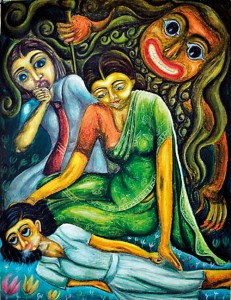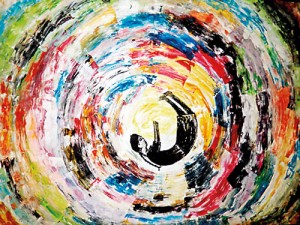Spot epilepsy through canvas
The International Epilepsy Day commemorative art
competition 2015 organised by the Departments of Paediatric Neurology at the Anuradhapura and Kurunegala Teaching Hospitals draws a great response
Epilepsy is a common malady endured by people with no racial, geographical or social class boundaries. Although it is a manageable health problem, lack of knowledge and rationality has clouded the issue of epilepsy even up to date. The campaign organised to run parallel with the first ever International Epilepsy Day on February 9, 2015, utilised art, with the earnest intention of touching hearts and minds of a wider community. 
Epilepsy is the commonest neurological disease originating from the brain. The brain itself has millions of nerve cells (neurons) which control the way we think, move and feel. Neurons do this by passing electrical signals between each other. If these signals are disrupted or too many signals are sent at once, a seizure (sometimes called a ‘fit’ or ‘attack’) is started off. The said commotions in neuronal signaling are attributable to putative genetic factors, underlying structural neurological disorders, or largely to unknown neuro-chemical mechanisms.
Anyone can have a single epileptic seizure at some point in their life. This is not the same as having epilepsy, which is a tendency to have repeated seizures. Thus to be given a diagnosis of epilepsy you will usually have had two or more seizures which are essentially originating from the brain. Symptomatology of the disease depends on the part of the brain involved. Accordingly a wide range of different seizure types and epilepsy syndromes have been defined by the authoritative world organisation, International League Against Epilepsy.
Patients with epilepsy are now successfully treated with pharmacotherapy, occasionally with neurosurgical techniques, as well as with psychological and social support.
Epilepsy has no racial, geographical or social class boundaries. It occurs in both sexes, at all ages; but has a higher preponderance to occur in children, and in ageing populations. There are relatively few studies available on the demography of epilepsy in total populations. However according to the WHO fact sheet, an estimated 50 million people endure epilepsy in the world, of which nearly 80% are found in developing

How she feels; A child’s painting of experiencing a seizure (above) and ( left ) another child’s painting of the erroneous belief in the ’evil eye’
regions.
The term epilepsy derives from the Greek verb epilambanein, meaning to be seized, to be overwhelmed by surprise. Epilepsy is an ancient disorder, which was seen in all civilisations and can be traced as far back as medical records exist.
Down the ages, epileptic attacks were thought to be the result of invasion and possession of the body by supernatural forces, usually malign or evil influences, requiring exorcism, incantations or other religious or social approaches. The true nature of epilepsy has long been distorted by these myths and fear. Unfortunately even today, the 21st century populace continues to hold mistaken notions about the disorder making people with epilepsy to suffer from stigma and discrimination.
The study of the artistic expression of people with epilepsy can potentially shed new light on the personal feelings and thoughts of people that are often overlooked in traditional clinical research. It can hopefully help to improve understanding of epilepsy while reducing the unjust stigma associated with this condition. It is our sincere hope that art will serve as a window through which people may gain a better understanding of epilepsy.
( The writer is a Consultant Paediatric Neurologist, Teaching Hospitals Anuradhapura and Kurunegala)
| Enhancing knowledge about epilepsy through their eyes The International Epilepsy Day Commemorative Art Competition – 2015 was organised by the Departments of Paediatric Neurology from the Anuradhapura and Kurunegala Teaching Hospitals with the objectives of; enhancing knowledge about epilepsy via self erudition, identifying the attitudes, myths and misconceptions in Sri Lankan society, and stimulating, enhancing and appreciating the creative expression of child with epilepsy. To accomplish these objectives a competition was conducted under three main categories; child with epilepsy, school children and the open category. They were asked to paint unreservedly on any theme based on epilepsy and were offered the opportunity of briefly writing-up their views. More than 500 paintings were received within a short period of time revealing the zest and zeal for the given challenge. The paintings in the category involving children with epilepsy were the most expressive. They illustrated and described the sensations they feel prior to developing a seizure (aura), their perception of the event and the post-event phenomena. They made this an opportunity to divulge their distress and wretchedness via brush and paint while some highlighted the benefits of appropriate treatment. One such painting portrayed a girl in black swirling in a multi-coloured background ( see right above). ”Epilepsy turned and twisted my whole life; this is how I feel, being spiralled and dragged in to a hollow from the colourful atmosphere I loved to be in,” she wrote. A child with epilepsy who gets seizures originating from the posterior (occipital) lobe drew figures in double, as she sees them during an event, with an elaborate description as she does not lose her awareness during the initial stage of the disease. “Alas, I got this unpleasant headache once more, with visual blurring; the ever so common tree in my garden became two, butterflies in pairs, twin birds’ nests. Amma……. I called and ran to her. Oh my! Who is my mum? I see two, I grabbed one, I felt the usual warmth and the fragrance of love, and that’s all I could remember”. A teenager with epilepsy drew a ring of gazing faces. “This is how I see, me lying on the ground after my attack. I’ve become the star, what an audience, peeping in, staring at me, with different expressions on their faces, ranging from empathy to sympathy from fear to sarcasm, some extending a caring hand while others being the guests of honour”. “I am a flower, with loosing petals” a child with epilepsy expressed while another said that his life is in fire stressing the stigma and decimation unfortunately allied to the disease. One drew a blooming lotus, with pills on the floating leaf to express the efficacy of medication while another highlighted the importance, the benefits by resembling medication to sunlight, which gives light and energy to all living beings on earth. Many paintings took one through the story, from the onset of epilepsy to malpractices, the proper treatment, and cure, flying to the top of the world leaving the dark robe of epilepsy behind. A few of the paintings expressed the myths, misconceptions and malpractices to highlight the contrary. A fallen girl on a bed of flowers, stiff with eyes rolled up, frothing from the mouth, surrounded by support, with the evil spirit in the background, the artist strongly affirms in her caption that epilepsy is not a result of possession or an evil eye as erroneously believed by many (see above) . Many drew a seizing child with an iron rod, or “giraya” kept in the hand with somebody trying to stop the attack, or to open the mouth. “All the actions above mentioned are malpractices, which should be prohibited and eliminated as they can positively provoke harm to a seizing child” they said. Some were posters to denote the danger, such as cycling, swimming, climbing, working with fire alone and / or unobserved. Epilepsy does not hamper education, play, extracurricular activities, or marriage some posters said. Some were symbolic portrayal of the given theme, with more to imagine, comprehend and grasp according to the knowledge, maturity of the viewer. |


